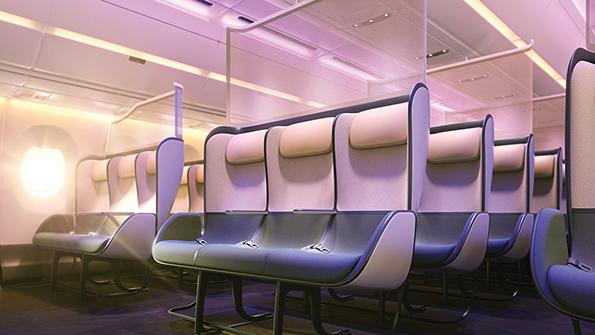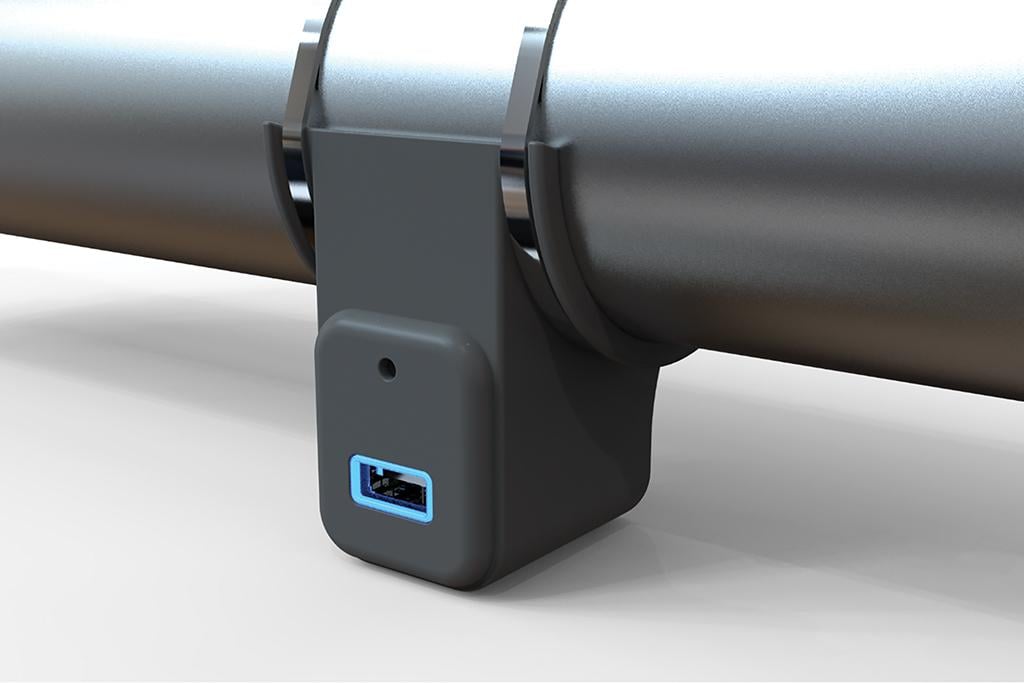Engineering Innovations Focus On COVID-19 Cabin Redesign

Before the novel coronavirus outbreak, engineering and modification was the fastest-growing segment of the commercial airline MRO market. Today, it is running at about 50% of what it was in 2019. But while the COVID-19 pandemic has upended the market, it also is driving new and evolving concepts in passenger safety and revenue generation for the post-COVID future.
Among the innovations being explored are revolutionary changes in cabin configurations, including Priestman-Goode’s “Pure Skies Rooms” and “Pure Skies Zones.” Discussions with the firm’s airline customers, seat vendors and suppliers indicated “it was time to think about the future and how airline cabins could be altered so people would have more confidence in flying” in the post-COVID-19 environment, says Luke Hawes, director of the London-headquartered design house.
Pure Skies Rooms, the designer’s business-class concept, offers each passenger a fully enclosed personal space, partitioned by full-height curtains, as well as a new seat design with minimal split lines and seam-welded fabrics, places where microbials could breed. The unit also contains antimicrobial materials and finishes, an inflight entertainment system (IFE) fully synchronized with the passengers’ personal electronic devices, as well as its own overhead luggage storage area and wardrobe.

Because each room is a complete module, PriestmanGoode will need to work with the airframe manufacturers to address “the architectural hurdles,” Hawes says. “This will be far more involved than installing new seats on seat tracks,” he adds.
Pure Skies Zones is how PriestmanGoode envisions a redesigned economy section. Greater separation will be achieved by installing transparent dividing screens in back of every other row, as well as staggered seating. The seats themselves would be designed with back-of-seat shells, without gaps, to eliminate trapped dirt. The split lines and hard-to-clean areas of the recline mechanism would also be eliminated by containing the mechanism within the fabric skin.
“The dividing screens not only enhance privacy but also provide the cabin itself with a more hygienic look and feel,” says Hawes. “There would be no increase in seat pitch, and revenue potential would not change. However, the seat design would result in a product that would cost more.”
Hawes reports that Pure Skies Rooms and Pure Skies Zones designs also target high-touch items—especially seat-back monitors. “We would totally eliminate them in favor of a passenger’s electronic device,” he says. “If passengers could stream content from the airline’s own server through a Wi-Fi connection, it would eliminate a high-touch item and the weight of the monitor and wiring. When not being used, the electronic device could be stored in a seat-back pocket.”
Ultraviolet (UV) lighting is another area of industry interest for its anti-microbial properties. “UV lighting may catch on if for no other reason than a ‘branding initiative’ to help improve revenue through passenger confidence,” says Teddy Gil, chief administrative officer of Sheffield Aerospace, an engineering consulting firm in Houston. Gil reports that Phillip Cheng, Sheffield’s director of operations and lead electrical engineer, is working with an unnamed client to provide the expertise for its design, installation and regulatory compliance requirements.
“UV lighting as an antimicrobial has been worked on since 2015 by different companies, but this project is the first prototype installation on an aircraft,” Gil states. The installation took place in December 2019 within a lavatory, but he notes that it can be placed throughout the cabin and galley, and it is being evaluated for a fleet-wide campaign.
The system components were designed for simplicity, using LED strips and the associated board that energizes them. “The design was intended for ease of installation, making it compatible with both retrofit and line fit,” he says.
Sheffield has proposed that the UV system would be in an active mode when the cabin is unoccupied, out of an abundance of caution to assure passenger safety. Asked if it would be effective against virus strains, Gil says that it was specifically designed to kill bacteria, and more research is required to determine its full potential.
An innovative project in development for the aircraft cabin involves Halo, an air-quality sensor system produced by IPVideo. For the past two years, Halo has been marketed to—and installed in—commercial buildings and educational facilities, such as public schools and college dorms, according to Mark Lebovitz, CEO of L2Aviation, IPVideo’s joint-venture partner for all aerospace markets, including military/government, business and general aviation, and Part 121 and Part 135 commercial operations.
“L2 Aviation is providing the avionics expertise and experience to both ruggedize and ‘aviationize’ the Halo design for the robust requirements of inflight environments,” says Lebovitz. “L2Aviation will develop the [supplemental type certificates] for FAA and foreign validation and [parts manufacturer approval of] the equipment for many aircraft types.”
Halo is composed of units or suites, each embedded with 12 sensors working in conjunction to detect environmental conditions and provide a multitude of measurements. An additional ozone sensor is to be added later this year. “No other product we know of has the ability to detect and measure chemicals in the air such as ozone, carbon dioxide and carbon monoxide; as well as [volatile organic compounds] and particulates impacting air quality,” he says. “It also detects environmental factors such as temperature, dew point and barometric pressure, plus lighting.”
The joint venture is targeting the Boeing 737 and Airbus A320 retrofit market initially. For a single-aisle airliner, three units would be placed in the cabin to create channels between multiple zones. “With three or more zones installed, the differences noted and trending between sensor-suite locations can be used to determine if a smell or other event started in a section of the cabin or in a common point like the pressurized bleed air from the engine,” explains Lebovitz.
Halo is enabled for the Internet of Things (IoT) for data transmission, using several modes of connectivity including wireless such as existing IFE equipment, and cellular for transmitting upon weight-on-wheels (WoW), or a parking brake.
“For aircraft connectivity systems like cellular (4G) and Gatelink Wi-Fi, which are designed or certified to operate only while the aircraft is on the ground, the WoW and/or parking brake discrete inputs enable the ground communication system to power-on the radio, connect and start transmitting the HALO air cabin data. In some configurations the data transfer can start when the aircraft lands. However, sometimes it is preferred to wait until the parking brake is set,” he explains.
Lebovitz adds that under some circumstances, Halo could tie in to L2’s other connectivity supplemental type certificates for the ability to interface with satcom or ACARS for real-time transmission and predictive maintenance—not just event-based reporting from the aircraft—and all without requiring human interaction. “The data packets are small and would not present a bandwidth penalty or be expensive to transmit over satellite or ACARS,” Lebovitz notes.
One innovation that could help the cash-strapped airlines is AAR’s In-Seat Power System (ISPS), which will enable airlines to generate extra revenue as passengers use the airline’s USB power to recharge their personal electronic devices (PED). If the airline selects AdPower, an optional, highly customized feature of the outlet units, ancillary revenue through advertising can be realized.
Customization for each operator is available via a software development kit that interfaces with each airline’s app. The software is compatible across Apple and Android devices and “provides the opportunity for dual revenue streams—charge-to-charge and advertisements on behalf of itself or partner brands,” says James Leech, an AAR Engineering Services senior manager. Operators have the choice when selecting the AdPower option to capture either, both or neither revenue stream.
“Assuming the USB outlet with AdPower is chosen, this will be the first such ISPS that enables airlines to generate ancillary revenue through advertisement income, displayed as passengers charge their personal electronic devices. It will also be the first device that enables the passenger to receive ISPS power through an airline’s app,” Leech says. The AdPower app will generate a code that activates the USB outlet to deliver power to the PED.
Leech points out that the ISPS will work if the app is pre-installed on the passenger’s PED. However, AAR is also exploring options with various inflight connectivity providers to determine the feasibility of launching the app through a browser-based application.
The AAR ISPS is available with two versions of USB Type A outlets from which the customer can choose. These include the traditional one-way outlet as well as a bidirectional outlet that allows a PED to be inserted into the outlet in two ways, reducing customer-induced damage. The outlet is installed on the seat spar instead of the seat back or armrest area.
“AAR has designed a USB outlet mounting bracket that can fit most seat types. Should a special type of seat installation be required, AAR will work with the customer to adapt our design for that particular seat,” Leech adds.
He explains that the ISPS was designed as a low-maintenance product. For example, the need to install a seat power box on each seat assembly has been eliminated. Instead, the robust USB power-supply units (PSU) are installed outboard of the sidewalls of the aircraft. “The AAR ISPS requires only 8 PSUs for a narrowbody aircraft as opposed to approximately 30 PSUs for a traditional ISPS,” Leech notes. Total weight of the outlet is 1.3 lb. per triple seat assembly. Installation time per seat assembly is 15-20 min. and can be accomplished during an overnight check.
AAR was in discussions with multiple airlines that were interested in installing the ISPS with the ancillary revenue features prior to COVID-19, says Leech. “We were preparing to launch it during [Aircraft Interiors Expo] 2020. Due to the pandemic, the launch has been delayed, but the design is ready to be incorporated,” he says.

